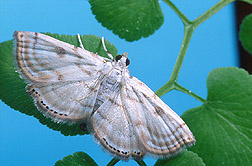This page has been archived and is being provided for reference purposes only. The page is no longer being updated, and therefore, links on the page may be invalid.
|
|
Moth Released to Curb Spread of Climbing Fern
By Alfredo FloresFebruary 14, 2005
WASHINGTON, February 14—More than 100 tiny moths from Australia were released in Florida this morning to begin a biological control effort against an invasive weed that has spread over more than 100,000 acres in the state.
Scientists with the Agricultural Research Service (ARS) and officials from the State of Florida released the moths this morning at the Jonathan Dickinson State Park in Hobe Sound, Fla. The moth, Austromusotima camptonozale, is the first biological control agent approved for release against the invasive weed Old World climbing fern, Lygodium microphyllum.
This aggressive vine has spread across south and central Florida, scaling the stems or trunks of other plants to form thick vegetative blankets. On the ground, it creates tough, spongy mats that smother grasses, low-growing shrubs and small trees.
"Land managers consider this fern to be the state's worst invasive species, so we hope the moth will begin to offer much-needed relief," said ARS entomologist Robert W. Pemberton, at the Invasive Plant Research Laboratory at Fort Lauderdale, Fla. He leads the international research effort to develop biological controls for the weed.
Climbing fern is native to the Old World tropics including Australia, Africa, tropical Asia and the Pacific Islands but doesn't cause problems in those areas, probably because natural enemies help keep it in check. Searching for natural enemies of the fern in its native habitat, scientists at the ARS Australian Biological Control Laboratory in Indooroopilly identified several promising candidates, including A. camptonozale. Then they tested these biocontrol candidates to make sure they would only feed on the fern and not on other, nontarget plants.
The moth released today measures just half an inch from wingtip to wingtip and is bright-white, with spots and stripes on its wings. The larvae of the moth feed on climbing fern's leaves, damaging the vines.
The Indooroopilly scientists shipped a supply of moths to the Florida Department of Agriculture and Consumer Service's biological control quarantine facility in Gainesville for three years of testing by scientists with the ARS Invasive Plant Research Laboratory and the University of Florida. Upon completion of those tests, federal and state approval was obtained to turn the moths loose at climbing-fern-infested sites in Florida. This biological control program is a collaborative effort among ARS, UF, SFWMD, and Florida Department of Environmental Protection.
Herbicides have been the major weapon against climbing fern, but the weed thrives in remote wetland areas that are difficult and expensive to treat. A. camptonozale and other biocontrol organisms may provide an effective and more environmentally friendly alternative to the use of herbicides in wetlands.
ARS is the U. S. Department of Agriculture's chief in-house scientific research agency.


